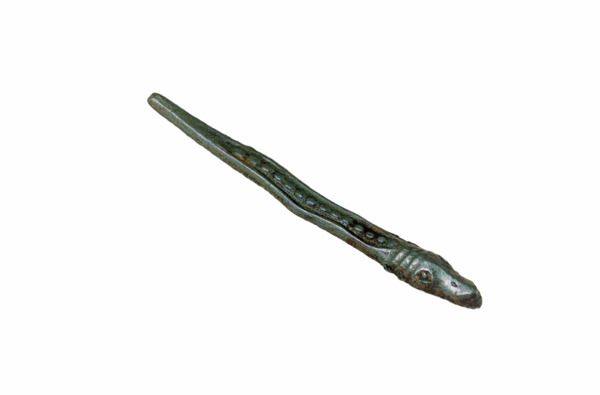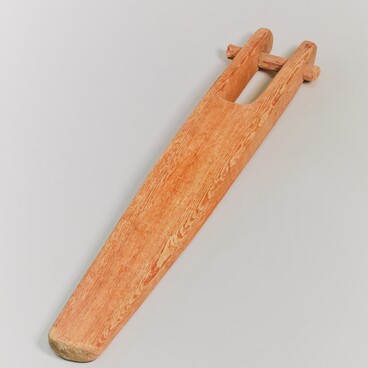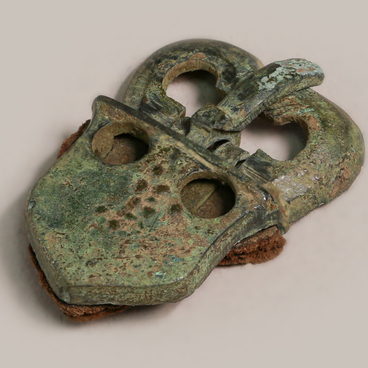The collection of the Nefteyugansk History and Art Museum Complex displays a bronze snake figurine. It was found during the excavations of the archaeological site — ancient settlement Sorovskoye 10 near Bolshoye Sorovskoye lake. This figure was given to the Museum of the Ob River in 2012. Nowadays, it is there on display. Researchers suggest that this zoomorph is approximately 1000 years old.
Sculptures of animals with relief ornaments are generally called “zoomorphic”. Scientists suggest that people began to make zoomorphic figures as soon as they mastered casting from bronze or iron. The first known finds date back to the 5th millennium BC. Idolized animals, predators, birds, and fantastic creatures, such as griffins were depicted most often. Zoomorphic style differed from simple images of animals — the subject had to conform with the decorative art instructions: the characters were placed symmetrically, the ornament had a certain rhythm, and the images of animals had conditionality.
Archaeologists most often find figures of bears, moose, or birds among all sculptures. Images of reptiles are rare.
Researchers believe that the images of medieval artistic metal plastics are connected with world order ideas of those years. For example, a bird — one of the most common characters — was perceived as an intermediary between the human world and the spirit world, a herald of the gods and a messenger of people. Reptiles symbolized the road to other worlds.
The snake from the Nefteyugansk collection was created in the 9th century AD. Medieval masters depicted it in a dynamic pose: a snake seems to be crawling. This effect is achieved due to a slightly curved body. The snake’s body is flat, and 14 oval reliefs are visible on its back. Medieval cast figures with a skeletal structure are often found on the territory of Western Siberia. Perhaps, the master has indicated the snake’s spine with patterned elements. The animal’s head is made more realistically: it is three-dimensional with detailed eyes, nostrils, and mouth. The realism and naturalness of the snake’s shape show the author’s skill.
Sculptures of animals with relief ornaments are generally called “zoomorphic”. Scientists suggest that people began to make zoomorphic figures as soon as they mastered casting from bronze or iron. The first known finds date back to the 5th millennium BC. Idolized animals, predators, birds, and fantastic creatures, such as griffins were depicted most often. Zoomorphic style differed from simple images of animals — the subject had to conform with the decorative art instructions: the characters were placed symmetrically, the ornament had a certain rhythm, and the images of animals had conditionality.
Archaeologists most often find figures of bears, moose, or birds among all sculptures. Images of reptiles are rare.
Researchers believe that the images of medieval artistic metal plastics are connected with world order ideas of those years. For example, a bird — one of the most common characters — was perceived as an intermediary between the human world and the spirit world, a herald of the gods and a messenger of people. Reptiles symbolized the road to other worlds.
The snake from the Nefteyugansk collection was created in the 9th century AD. Medieval masters depicted it in a dynamic pose: a snake seems to be crawling. This effect is achieved due to a slightly curved body. The snake’s body is flat, and 14 oval reliefs are visible on its back. Medieval cast figures with a skeletal structure are often found on the territory of Western Siberia. Perhaps, the master has indicated the snake’s spine with patterned elements. The animal’s head is made more realistically: it is three-dimensional with detailed eyes, nostrils, and mouth. The realism and naturalness of the snake’s shape show the author’s skill.



